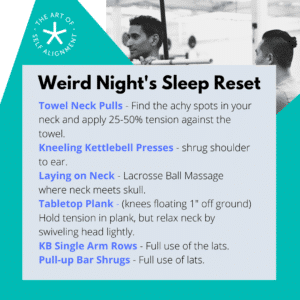Waking up with strange aches and pains is no fun. Want to know what to do about it?
My client Jane (not her real name) logged onto to our Zoom session this past Thursday, and the first thing she said to me was, “today’s going to be a Reset workout Brandon. I had a weird night of sleep and my neck doesn’t feel good.”
So for the next 20 minutes, we practiced the pain-management techniques I taught her. She sighed with relief, and said, “you need to call this the Weird Night’s Sleep Reset. That should be in your next newsletter.”
The Weird Night’s Sleep Routine is at the bottom if you want to skip the rest of the story.
Jane has been working with me for over a year now (mostly virtually via Zoom). When she came to me at my Olympic-lifting gym last September, she was deeply skeptical of mainstream fitness and could not find a way to ENJOY movement without fear of being pushed beyond her limits. She had been through a ton of trainers and group classes.
Like so many people, Jane had a conflicting message inside her. She had the usual aches and pains that come with aging, a busy schedule, combined with a social pressure to “exercise.” She felt like she had to push herself anytime she went to the gym to get the most out of her precious time spent. But the lingering of aches and pains made it unappealing.
So the first session we did, I offered her three choices of how we were going to spent the session: reset, maintain, or build.
Jane had never been asked what she felt like doing in a training session. Ever.
This shocked her that she could guide her own session. She then asked if we could address her two pain points in the hip and neck. I said, “Of course. I will always give you a choice because I’m not a drill sergeant.”
Let’s look at the three choices I gave Jane, and that you have anytime you are going to train.
A. Reset – This is mostly about pain reduction and alleviating stiffness that inhibits free movement. This is the best place to start because it’s hard to do athletic movements when your body is saying, “hey this thing hurts in your knee.”
B. Maintain – Nothing new here, just maintaining skills and movements you already know how to do. We call this “punching the clock.” Most workouts will be in this category.
C. Build – Building new skills is hard when you don’t have energy to spend. These workouts are generally for when you have a surplus of energy and doing things that require high levels of concentration.
When I first started training Jane, it took about three hours to show her all the necessary pain-management skills. Then, to her surprise we could begin doing Maintain and Build workouts.
In our session last week, it took about 20-minutes to reset her weird night of sleep. Then she smiled and said she felt much better. Then we moved on to build some fun skills like front splits training and upper body strengthening.
“Reset” workouts don’t need to take a ton of time. And once they are done, you can move on to exercise without feeling the inner conflict. I would love to teach you how to do this. Just respond to this email with what your pains are and we can talk.
I’ll be sending the companion follow-along video later this week.
In the meantime, here’s a sneak peak at the Weird Night’s Sleep Reset. This routine will only take 10 minutes and can be done anytime.


